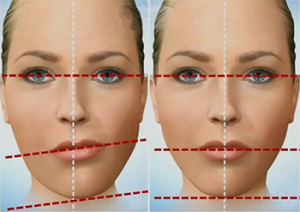Facial Asymmetry

Facial asymmetry simply means that a feature on one side of the face does not appear the same on the other side. Asymmetry occurs when the upper jaw maxilla does not properly line up with lower jaw or the mandible.
What causes facial asymmetry?
- Misalignment of the teeth
- Disorders of the temporomandibular joint
- Genetics
- Accident and Injuries that result in damage to the face
- Mouth breathing and Improper tongue position
Common symptoms of an asymmetrical jaw
- An uneven or a lop-sided smile is a common sign of facial asymmetry.
- Clicking or popping sound on opening or closing of mouth
Braces cannot correct all facial asymmetries, but they can often lead to noticeable improvements which occur in the lower portion of the face. Opting for braces leads towards a symmetrical face and provides a better dental and overall health.
Bite Problems, Crowded Teeth and Uneven Spaces between teeth.
Bite issues occur in cases where the upper and the lower teeth are not properly aligned relative to one another. Crowded teeth, particularly if the crowding is asymmetrical, can contribute to the asymmetrical appearance around the mouth. Gaps in the teeth can have a similar effect.
Functional Issues
When teeth don’t meet correctly it can lead to functional problems such as difficulties in chewing or speaking. This can also strain facial muscles leading to imbalances. Braces can help in resolving these strains and help in fostering symmetry.
Temporomandibular Joint and Facial Asymmetry
Temporomandibular dysfunction is usually the cause of jaw asymmetry. It comes with some symptom depending upon how serious the condition is:
- Headache and pain in the jaw area
- Limited movements while chewing
- Popping sound when opening or closing your mouth
- Stiffness in the back of the neck
How orthodontic treatment can correct the facial asymmetry?
Orthodontic treatment plays a vital role in correcting bite problems like overbite, underbite, crossbite, crowding of teeth, uneven spaces etc. Most of the times bite issues lead to facial imbalance.
Do people notice facial asymmetry?
Almost all faces are a bit asymmetrical. Person may notice their own facial asymmetry which other people probably are not aware about.
Does chewing on one side make my jaw asymmetrical?
Just like how certain muscles have effects due to intense workouts, the muscles in our jaw can also experience similar effects.
No matter what your age is, the easiest way to correct asymmetry is with the help of braces or in severe cases with the help of a corrective jaw surgery.
You can schedule a consultation appointment with Dr. Seema Bansal for more informantion.

Very well explained! ??
Thank you Komal
Yes,not so uncommon problem.
People with straight teeth also may ot for orthodontic correction if they suffer from perceivable facial asymmetry.
Most imp is this awareness.
Very informative and well explained.
Thank you Aastha
Thank you Jaya
Very nuanced and well explained ?
Thank you Sneha